2013 Maha Kumbh Mela at Allahabad, Uttar Pradesh, India
With 100 milion Pilgims visiting during the 55 day festival, its the biggest religious gathering in the world.
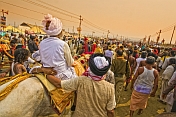 When Jupiter is in the sign of Taurus and the Sun is in the sign of Capricorn, the great Hindu festival of Kumbh Mela is celebrated at Prayag, the confluence of three rivers: Ganges, Yamuna, and Saraswati, just outside the northern city of Allahabad, in India's Uttar Pradesh state. Hindus believe a festival dip at Sangam - where the rivers meet - will cleanse sins and help bring salvation. Due to various complicated reasons best understood by Indian astrologers, 2013 was to be a 'Great' or 'Maha' Kumbh Mela, something that happens just once in 144 years, so I was especially priveleged to be able to attend this amazing festival, and capture some of the images that I saw there. The photographs on this page (all available for licensing) are just a small selection from the images I was able to make during my 6 day visit to the Mela.
When Jupiter is in the sign of Taurus and the Sun is in the sign of Capricorn, the great Hindu festival of Kumbh Mela is celebrated at Prayag, the confluence of three rivers: Ganges, Yamuna, and Saraswati, just outside the northern city of Allahabad, in India's Uttar Pradesh state. Hindus believe a festival dip at Sangam - where the rivers meet - will cleanse sins and help bring salvation. Due to various complicated reasons best understood by Indian astrologers, 2013 was to be a 'Great' or 'Maha' Kumbh Mela, something that happens just once in 144 years, so I was especially priveleged to be able to attend this amazing festival, and capture some of the images that I saw there. The photographs on this page (all available for licensing) are just a small selection from the images I was able to make during my 6 day visit to the Mela.
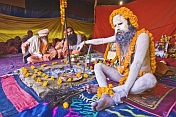 When it comes to superlatives, the Kumbh Mela rules the roost. As a once-in-149-year event, it attracts huge numbers of visitors. Estimates generally agree on 100 million people attending over the two month period of this Kumbh Mela, with up to 50 millions there on one single day: the Mauni Amavasya Snana which took place on the 10th of February. This makes the Kumbh Mela not only the largest religious gathering in the world, but also makes the site the most populous place on earth, with numbers far exceeding the biggest of world cities. I was there for the second most important day: the Basant Panchami Snana which took place on the 15th February, when an estimated 30 millions attended and tried to take their sacred bath in the river. It was quite busy enough for me !
When it comes to superlatives, the Kumbh Mela rules the roost. As a once-in-149-year event, it attracts huge numbers of visitors. Estimates generally agree on 100 million people attending over the two month period of this Kumbh Mela, with up to 50 millions there on one single day: the Mauni Amavasya Snana which took place on the 10th of February. This makes the Kumbh Mela not only the largest religious gathering in the world, but also makes the site the most populous place on earth, with numbers far exceeding the biggest of world cities. I was there for the second most important day: the Basant Panchami Snana which took place on the 15th February, when an estimated 30 millions attended and tried to take their sacred bath in the river. It was quite busy enough for me !
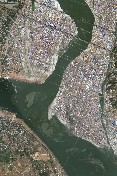 To prepare for such vast numbers of Pilgrims and visitors, the authorities have a mammoth task before them. Twenty square kilometres of site to level and prepare. Filtered water that can supply 80 million litres. Nearly 26,000 tonnes of emergency wheat and rice stores. Electricity poles. Floodlights. Looking for a toilet? There's 35,000 of them. Roads. Eighteen pontoon bridges. All need to be in a working condition when the Pilgrims arrive. There's a huge police and army presence too, of some 30,000 police to control the large numbers of attendees. In the past there have been riots and stampedes - luckily not like the 18th Century, when riots and bloody fights used to be common. In 1760 on the last day of bathing the rival mobs of the Gusain and Byragi sects had a battle in which eighteen thousand people are said to have perished. In 1795 the Sikh pilgrims slew five hundred Gusains. Today, the police and army personnel helped by modern technology do a wonderful job to make sure that everyone's visit goes as smoothly as possible. Disasters inevitably happen - this year some 30 people were killed in a stampede on a railway footbridge. One person was burnt alive at a fire in one of the camps. As horrific as these incidents are, it is amazing that there are not more when such great numbers gather together.
To prepare for such vast numbers of Pilgrims and visitors, the authorities have a mammoth task before them. Twenty square kilometres of site to level and prepare. Filtered water that can supply 80 million litres. Nearly 26,000 tonnes of emergency wheat and rice stores. Electricity poles. Floodlights. Looking for a toilet? There's 35,000 of them. Roads. Eighteen pontoon bridges. All need to be in a working condition when the Pilgrims arrive. There's a huge police and army presence too, of some 30,000 police to control the large numbers of attendees. In the past there have been riots and stampedes - luckily not like the 18th Century, when riots and bloody fights used to be common. In 1760 on the last day of bathing the rival mobs of the Gusain and Byragi sects had a battle in which eighteen thousand people are said to have perished. In 1795 the Sikh pilgrims slew five hundred Gusains. Today, the police and army personnel helped by modern technology do a wonderful job to make sure that everyone's visit goes as smoothly as possible. Disasters inevitably happen - this year some 30 people were killed in a stampede on a railway footbridge. One person was burnt alive at a fire in one of the camps. As horrific as these incidents are, it is amazing that there are not more when such great numbers gather together.
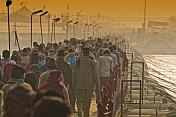 Health issues are also taken very seriously. There's a complete 100-bed hospital and 12 smaller health centres ready to treat patients around-the-clock and react in the event of major emergencies. 243 doctors, 257 paramedics and 600 other medical staff are there to run them. There are 75 ambulances to ferry patients or deal with emergency situations, and four river ambulances as well. Many of the visitors come from remote villages, where a trip to the doctor means a journey of several days, so the free hospital services at the Kumbh Mela are very welcome - even before the Mela got fully under way, the hospital had been getting around 1,500 patients a day since it opened on 15 December. In the past, cholera epidemics were common, and many died as a result. Today, a huge army of some 10,500 cleaners and sweepers, most from the lowest 'Untouchable' or 'Dalit' sections of society, unseen and unthanked, labor tirelessly to keep the site clean, tidy, and free of disease. They will tackle an estimated 40 to 50 tonnes of rubbish a day, rising to 100 to 150 tonnes on the big bathing days.
Health issues are also taken very seriously. There's a complete 100-bed hospital and 12 smaller health centres ready to treat patients around-the-clock and react in the event of major emergencies. 243 doctors, 257 paramedics and 600 other medical staff are there to run them. There are 75 ambulances to ferry patients or deal with emergency situations, and four river ambulances as well. Many of the visitors come from remote villages, where a trip to the doctor means a journey of several days, so the free hospital services at the Kumbh Mela are very welcome - even before the Mela got fully under way, the hospital had been getting around 1,500 patients a day since it opened on 15 December. In the past, cholera epidemics were common, and many died as a result. Today, a huge army of some 10,500 cleaners and sweepers, most from the lowest 'Untouchable' or 'Dalit' sections of society, unseen and unthanked, labor tirelessly to keep the site clean, tidy, and free of disease. They will tackle an estimated 40 to 50 tonnes of rubbish a day, rising to 100 to 150 tonnes on the big bathing days.
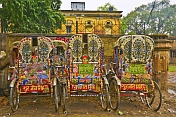 Just getting that many people too and from the site beggars belief. Indian Railways run many special trains. Buses constantly stream in from cities all over the country. I started my journey at the nearby city of Varanasi, just 90km away, and because of the huge crush expected on the railways, I went by bus. The organisation worked here, too. A full bus left the Varanasi Station Bus Stand every two minutes. Everyone had a seat. The roads were jammed with traffic, but the police did all they could to keep things flowing. Once over the huge Lal Bahadur Shastri Bridge, that crosses the Ganges River and provides an astonishing view of the entire Kumbh Mela site, there were still bicycle and auto-rickshaws, tempos, and tongas to transport the pilgrims to their individual camp. I was staying in Sector 14, to the south of the site, but managed to get quite close on a tempo, and completed the final leg by foot.
Just getting that many people too and from the site beggars belief. Indian Railways run many special trains. Buses constantly stream in from cities all over the country. I started my journey at the nearby city of Varanasi, just 90km away, and because of the huge crush expected on the railways, I went by bus. The organisation worked here, too. A full bus left the Varanasi Station Bus Stand every two minutes. Everyone had a seat. The roads were jammed with traffic, but the police did all they could to keep things flowing. Once over the huge Lal Bahadur Shastri Bridge, that crosses the Ganges River and provides an astonishing view of the entire Kumbh Mela site, there were still bicycle and auto-rickshaws, tempos, and tongas to transport the pilgrims to their individual camp. I was staying in Sector 14, to the south of the site, but managed to get quite close on a tempo, and completed the final leg by foot.
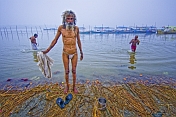 So what is it like visiting such a huge gathering? For me, a wonderful experience, and something that could only happen in India. Everywhere I went, I was greeted by friendly and welcoming people. Most spoke no English. Many had rarely if ever seen a white face before. There was no threat of personal violence, as would happen in South America or parts of Africa. Despite the huge crowds, I had nothing stolen, or my pocket picked. Whenever I needed a toilet, there was one close by. Chai sellers roamed the site, and it was easy to buy small snacks such as pakora or samosa, which of course were all vegetarian. Very few people objected to having their photograph taken. Some insisted on it!
So what is it like visiting such a huge gathering? For me, a wonderful experience, and something that could only happen in India. Everywhere I went, I was greeted by friendly and welcoming people. Most spoke no English. Many had rarely if ever seen a white face before. There was no threat of personal violence, as would happen in South America or parts of Africa. Despite the huge crowds, I had nothing stolen, or my pocket picked. Whenever I needed a toilet, there was one close by. Chai sellers roamed the site, and it was easy to buy small snacks such as pakora or samosa, which of course were all vegetarian. Very few people objected to having their photograph taken. Some insisted on it!
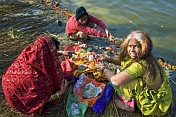 During my six day visit to the Mela, I made a huge effort to be out amongst the pilgrims as much as possible. I would leave my camp each morning well before dawn, and walk to the nearest pontoon bridge that took me across the Ganges River and into the heart of the festival. Although the sky was still dark, the bathing ghats were lit up with thousands of electric bulbs. Even at that early hour there would be many devotees performing their holy bath in the chilly waters. Thousands of pilgrims had already taken a dip in the holy waters, and thousands more were lining up for their turn. As the sun rose over the waters I could see the details of their devotion. Incense sticks or small ceremonial fires burning by the banks of the river. Garlands of marigold flowers draped on the sand, or tossed into the water for the current to sweep downstream. Tiny paper boats filled with flowers and a burning candle: a floating temple on the holy Ganges river. People changing their wet clothes and saris, but always decorously, privately, and with extreme regard to others. Privacy is not an option when you are sharing your ground with 50 million other people, but somehow the dip in the river is made, bodies are dried, and nothing untoward is revealed.
During my six day visit to the Mela, I made a huge effort to be out amongst the pilgrims as much as possible. I would leave my camp each morning well before dawn, and walk to the nearest pontoon bridge that took me across the Ganges River and into the heart of the festival. Although the sky was still dark, the bathing ghats were lit up with thousands of electric bulbs. Even at that early hour there would be many devotees performing their holy bath in the chilly waters. Thousands of pilgrims had already taken a dip in the holy waters, and thousands more were lining up for their turn. As the sun rose over the waters I could see the details of their devotion. Incense sticks or small ceremonial fires burning by the banks of the river. Garlands of marigold flowers draped on the sand, or tossed into the water for the current to sweep downstream. Tiny paper boats filled with flowers and a burning candle: a floating temple on the holy Ganges river. People changing their wet clothes and saris, but always decorously, privately, and with extreme regard to others. Privacy is not an option when you are sharing your ground with 50 million other people, but somehow the dip in the river is made, bodies are dried, and nothing untoward is revealed.
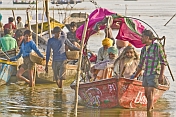 Strolling further along the banks, I found my way to the area of rowing boats. These frail craft will take pilgrims, for a fee, to the exact point in the waters where the union between the Ganges, the Yamuna, and the mythical Saraswati Rivers are believed to take place. If the sandbanks are high enough, it is even possible to get out and walk in the centre of the waters. Like most other purveyors of transport in India, the boatmen on the Ganges bargain hard, quoting fabulous sums for their services, then slowly dropping if sufficient disinterest it shown. There are plenty of boats, but also plenty of pilgrims, and for the majority of the pious, a boat ride to the Sangam is high on their list of priorities. I am sure that many of these boatmen will have little need to work until the next Kumbh Mela, in another 12 years time.
Strolling further along the banks, I found my way to the area of rowing boats. These frail craft will take pilgrims, for a fee, to the exact point in the waters where the union between the Ganges, the Yamuna, and the mythical Saraswati Rivers are believed to take place. If the sandbanks are high enough, it is even possible to get out and walk in the centre of the waters. Like most other purveyors of transport in India, the boatmen on the Ganges bargain hard, quoting fabulous sums for their services, then slowly dropping if sufficient disinterest it shown. There are plenty of boats, but also plenty of pilgrims, and for the majority of the pious, a boat ride to the Sangam is high on their list of priorities. I am sure that many of these boatmen will have little need to work until the next Kumbh Mela, in another 12 years time.
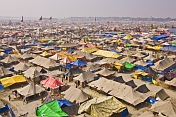 Away from the river, there are acres and acres of tents. Many of them belong to the great religious organisations or 'Akharas', where the colorful nagas or sadhus can be visited, chatted with, and photographed. Though often drifting in a state of mind quite different to their visitors, the chilum-smoking holy-men recognise the power of their image, and often demand small sums before they will allow an image to be taken. Cameras have been smashed in the past when payment is refused. Some are snooty, self important, dismissive and contemputous of their visitors. Others are friendly, and take time to chat over a glass of tea, and explain how their belief system works. Just like with ordinary people, it doesn't pay to generalise about holy men. Though I visited some of these people, and was suitably awed by various acts of yogic impossibility, I prefered to spend my time with the ordinary pople of the Mela, and watch their approach to this once in a lifetime cosmic expedition.
Away from the river, there are acres and acres of tents. Many of them belong to the great religious organisations or 'Akharas', where the colorful nagas or sadhus can be visited, chatted with, and photographed. Though often drifting in a state of mind quite different to their visitors, the chilum-smoking holy-men recognise the power of their image, and often demand small sums before they will allow an image to be taken. Cameras have been smashed in the past when payment is refused. Some are snooty, self important, dismissive and contemputous of their visitors. Others are friendly, and take time to chat over a glass of tea, and explain how their belief system works. Just like with ordinary people, it doesn't pay to generalise about holy men. Though I visited some of these people, and was suitably awed by various acts of yogic impossibility, I prefered to spend my time with the ordinary pople of the Mela, and watch their approach to this once in a lifetime cosmic expedition.
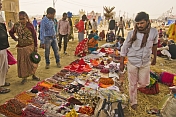 There were plenty stalls selling everything that a pilgrim might need. Holy pictures. Saffron cloth. Rudraksha beads, and brass images of whichever God you favor. Plastic containers to take some holy Ganges water back home to your temple. Colored powder for making the sacred mark on the forehead. Necklaces to drape around a favored holy man. Then there are also plenty of mementoes and souvenirs of your visit to the Maha Mela for those back home who couldn't make the arduous journey. Plastic bangles. Children's toys. A new rolling pin. 3-D images of Shiva and Vishnu. No one left behind will be forgotten. Barbers do a roaring trade shaving heads of the faithful. The traditional priests who keep family records set up their stalls and do good business too, updating genealogies and performing ceremonies for the souls of the dead.
There were plenty stalls selling everything that a pilgrim might need. Holy pictures. Saffron cloth. Rudraksha beads, and brass images of whichever God you favor. Plastic containers to take some holy Ganges water back home to your temple. Colored powder for making the sacred mark on the forehead. Necklaces to drape around a favored holy man. Then there are also plenty of mementoes and souvenirs of your visit to the Maha Mela for those back home who couldn't make the arduous journey. Plastic bangles. Children's toys. A new rolling pin. 3-D images of Shiva and Vishnu. No one left behind will be forgotten. Barbers do a roaring trade shaving heads of the faithful. The traditional priests who keep family records set up their stalls and do good business too, updating genealogies and performing ceremonies for the souls of the dead.
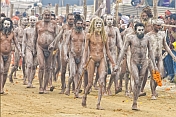 On a holy bathing day, such as Basant Panchami or Rath Saptami Snana, the spectacle grows even more intense. The Nagas - the ash smeared naked holy men we are so familiar with - get a special slot for their bathing, and are often escorted by squads of Indian Special Forces, though whether this is to protect the Nagas from the crowds or the crowds from the Nagas (who have a feared reputation for violent exuberance), no one is quite sure. After they have head their turn, the lesser holy men make their sacred dip. Carrying pennants, swords and banners, many dance or beat on drums. Some arrived on gaudily decorated chariots or proud horses. The water was a sea of saffron robes and flowers.
On a holy bathing day, such as Basant Panchami or Rath Saptami Snana, the spectacle grows even more intense. The Nagas - the ash smeared naked holy men we are so familiar with - get a special slot for their bathing, and are often escorted by squads of Indian Special Forces, though whether this is to protect the Nagas from the crowds or the crowds from the Nagas (who have a feared reputation for violent exuberance), no one is quite sure. After they have head their turn, the lesser holy men make their sacred dip. Carrying pennants, swords and banners, many dance or beat on drums. Some arrived on gaudily decorated chariots or proud horses. The water was a sea of saffron robes and flowers.
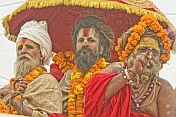 With the early bathing out of the way, there will be long processions through the Mela site, with many vehicles decorated with flowers and banners to parade the holy men and chiefs of the various Mutts before their devoted admirers. Huge crowds throng the route, and it is only with great skill on the part of the police and army that order is maintained. The crowds cheer, the holy men wave and throw marigold blossoms, and I consider myself very lucky to get in front of the barriers and walk with the nagas and the vehicles along the actual parade path itself, snapping photographs at every turn. Its a riot of color, a riot of sound, and a riot of affection from the crowds for their idols. There really is nothing quite like the Kumbh Mela, but don't just believe me - just ask anyone of the other 100 million people here, and they will tell you the same !!
With the early bathing out of the way, there will be long processions through the Mela site, with many vehicles decorated with flowers and banners to parade the holy men and chiefs of the various Mutts before their devoted admirers. Huge crowds throng the route, and it is only with great skill on the part of the police and army that order is maintained. The crowds cheer, the holy men wave and throw marigold blossoms, and I consider myself very lucky to get in front of the barriers and walk with the nagas and the vehicles along the actual parade path itself, snapping photographs at every turn. Its a riot of color, a riot of sound, and a riot of affection from the crowds for their idols. There really is nothing quite like the Kumbh Mela, but don't just believe me - just ask anyone of the other 100 million people here, and they will tell you the same !!
The photographs on these pages were all taken during my recent visit to the 2013 Maha Kumbh Mela. Click any image to see a larger version. The photographs are all available for licensing in a range of sizes - please Contact Me for details.
Note: The above satellite image was collected February 8, 2013, by +DigitalGlobe. View the imagery on Google Maps (http://goo.gl/tc5oa  ) or grab stills from this Google Drive album (http://goo.gl/74ndU ) or grab stills from this Google Drive album (http://goo.gl/74ndU  ). Thanks to Google/DigitalGlobe for use of the image. ). Thanks to Google/DigitalGlobe for use of the image.
|
Tag Cloud
Popular searches on this site.
Latest Photos
Error: 1226 - User 'gnomepla_ei8ic' has exceeded the 'max_questions' resource (current value: 300000) |




